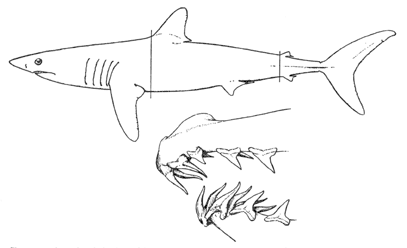Sharp-nosed mackerel shark Isurus oxyrinchus Rafinesque 1810
ATLANTIC MAKO
[Bigelow and Schroeder, 1948 p. 124.]
Description—
This shark resembles the common mackerel shark so closely that we need merely point out the points of difference. Most obvious of these is that while the first dorsal originates about above the armpits of the pectorals in the common mackerel shark, it stands over or behind the inner corner of the pectoral in the mako, and that the second dorsal originates a short distance in front of the anal. The teeth, too, differ rather noticeably in appearance, for while of the same awl-like type, those of the mako lack the lateral spurs or denticles that are characteristic of all but the smallest porbeagles, and those in the front part of the mouth are conspicuously flexuous in form. The mako, too, is more slender bodied; its snout is more narrowly conical; its upper and lower caudal lobes are more nearly equal in length; and the forward part of its caudal fin lacks the secondary lateral keels that are to be seen on the caudal fin of the porbeagle (cf. fig. 6 with fig. 5).
Color—
Deep blue-gray above when fresh caught, appearing cobalt or ultramarine in the water, with gradual transition along the sides to snow-white below; but turning dark slate gray above soon after death (especially if preserved), and to bluish white or pale dirty gray below and on the lower surfaces of the pectorals.
Size—
The maximum length reported for a specimen of the Atlantic mako that was actually measured is about 12 feet,[38] though it has been said to grow to 13 feet. The largest western Atlantic specimen of which we find definite record, taken off St. Petersburg, Fla., was 10 feet 6 inches long, and one nearly as large (10 ft. 2 in.) was caught off New York Harbor many years ago. But the common run caught off the middle Atlantic United [page 24] States are perhaps 5 to 8 feet long. Males of about 6 feet are sexually mature (as indicated by the claspers). Recorded weights at different lengths are about 135 pounds at 6 feet, 230 pounds at 7 feet 8 inches; and about 300 pounds at 8 feet. The heaviest Atlantic mako caught on rod and reel of which we have found record was one of 786 pounds taken off Bimini, Bahamas, by Ernest Hemingway in 1936; the largest Pacific mako one of 798 pounds, taken by E. White-Wickham off New Zealand.[39]
Habits—
This is one of the most active and swift swimming of the sharks. In seas where it is more common than it is in our Gulf, it is often seen swimming at the surface, and it is famous for its habit of leaping clear of the water, not only when hooked, but under natural conditions. Seemingly it preys chiefly on schools of smaller fishes of the mackerel and herring tribes. But it also attacks larger fishes. A 730-pound mako, for example, that was harpooned near Bimini in the Bahamas, contained a 120-pound swordfish (Xiphias gladius) almost entire, while one weighing about 800 pounds, harpooned off Montauk, Long Island, was seen attacking a swordfish, and was found when landed to contain a large amount of its flesh.[40]
Young embryos of the mako, like those of the porbeagle (p. 22), have greatly dilated stomachs, being nourished on the unfertilized eggs that he near them in the oviducts, and they are very large at birth, relative to the size of the mother.
General range—
This is an oceanic shark, of the tropical and warm-temperate belts of the Atlantic north and south, including the Mediterranean in the east and the Caribbean and Gulf of Mexico in the west. It is represented in the corresponding thermal belts of the Pacific and Indian Oceans by a close ally, the Pacific mako Isurus glaucus.
Occurrence in the Gulf of Maine—
The center of abundance for the mako lies in warmer seas to the southward of our Gulf. Considerable numbers journey northward, however, in summer along the continental shelf, as far as to the offing of southern New England, and a few are caught off Woods Hole. One of the earliest accounts of it in American waters was based partly on one from Cape Cod. During the past few summers we have heard repeatedly of makos seen jumping, or occasionally hooked near the northern end of [page 25] Cape Cod, and in the summer of 1941 one about six feet long was landed on rod and reel in the southern side of Massachusetts Bay near Plymouth.[41] Thus stray individuals may be expected to visit the southern part of the Gulf in most summers, though we have never met it there ourselves. It has even been reported as far north as Seguin Island, Maine, but without convincing evidence that the shark in question was not a porbeagle.[42]
Importance—
The chief importance of the Atlantic mako, as of its Indo-Pacific relative, is as a game fish, because of its fast runs when hooked and of its habit of leaping. But it is not plentiful enough anywhere in the Gulf of Maine to be worth fishing for there especially.
[38] 3.7 meters as calculated from the size of its jaws.
[39] A South African shark of 2,176 pounds, landed on rod and reel, and reported as a mako, is proved by the photograph of its teeth (London Illus. News, July 14. 1928, p. 53) to have been a maneater (Carcharodon).
[40] See Farrington (Field and Stream, vol. 47, Feb. 1943) for these instances of the mako attacking swordfish, and for other interesting notes on this shark.
[41] Information from Dr. W. J. Mixter.
[42] Various early reports of it in the northern part of the Gulf seem to have referred, actually, to the porbeagle.
